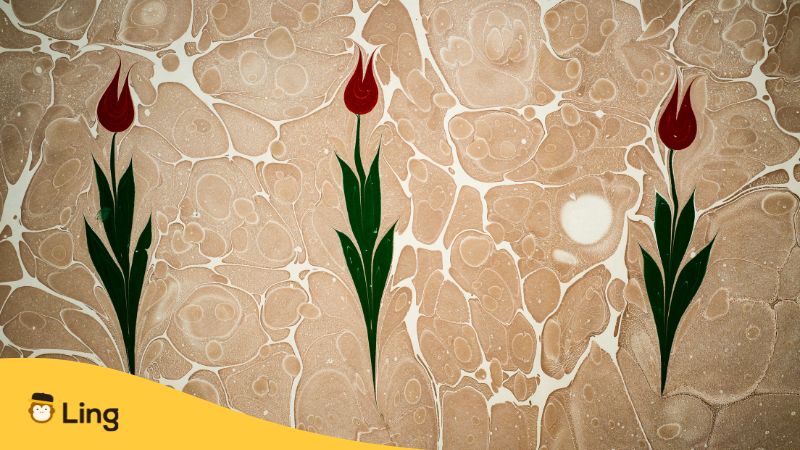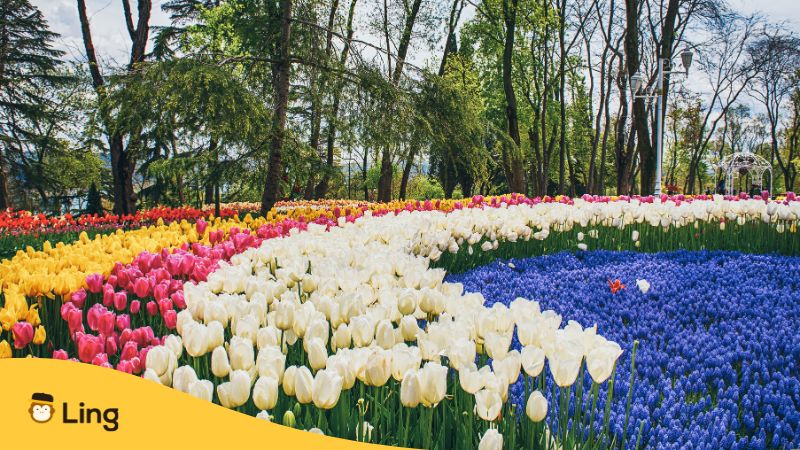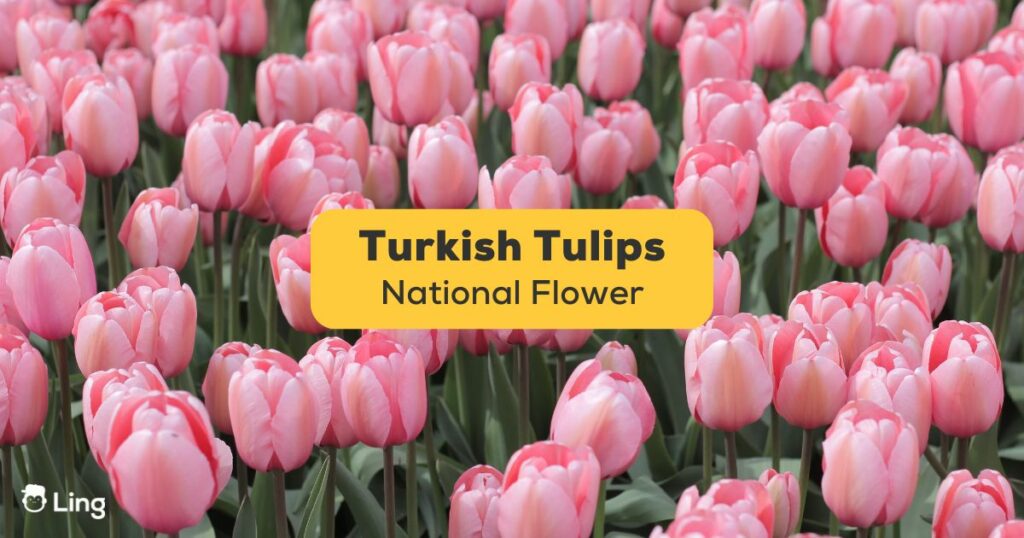Today, the Netherlands is the number one country in tulip production and export, but did you know that they were introduced to the flower thanks to the Ottoman Empire in the 16th century?
With spring’s arrival, Turkish tulips have bloomed, and gardens all over Istanbul paint the city in vibrant colors. You can see this beautiful flower everywhere in Turkey, from parks to artworks to songs, because the tulip is the country’s national flower. But why tulip and not any other flower? We’ll discover the answer in today’s blog post!
Table of Contents:
- What Is A Tulip?
- Why Is Tulip The National Flower Of Turkey?
- The Importance Of Tulips In Turkish Culture And Art
- The Tulip Era In The Ottoman Empire
- How Turkish Tulips Spread Worldwide
- Istanbul Tulip Festival
- Related Turkish Vocabulary
- Final Words
What Is A Tulip?
Tulips, or genus tulipa, belong to the lily family (liliaceae) and have about 100 species. They are originally native to Turkey and Central Asia. Tulips are one of the most vibrant and colorful spring flowers and are very easy to grow: just plant the bulbs in the fall, and tulips will bloom next spring! Nowadays, tulips are popular garden flowers used as indoor decor.
Why Is Tulip The National Flower Of Turkey?
In Turkish culture, the tulip (lale) symbolizes perfectionism, deep love, feminine beauty, and paradise. The tulip’s physical features are likened to the Islamic context. For example, the tulip’s vertical petals resemble a mosque’s minarets, while the middle part resembles the dome. Moreover, tulips represent the oneness of Allah in Islamic symbolism, since they grow only one flower from a single seed.
Furthermore, the word tulip resembles the word Allah in Ottoman script, since they are written with the same letters. When you read it backward it becomes hilal, which means crescent, and as you may know, the crescent moon is considered the symbol of Islam (and it’s also in the Turkish flag).

How Turkish Tulips Spread Worldwide
Nobody knows for sure how or by whom Turkish tulips reached Europe, but according to common belief, Flemish ambassador Ogier Ghiselin de Busbecq brought the first tulips to Europe from Turkey.
According to the story, Busbecq saw a tulip field on the road to Constantinople (now Istanbul) in the spring of 1554. He thought the shape of the flower looked like a turban, a type of headscarf, and noted the flower’s name as “tulipan.”
Though we’ve always called this flower “lale,” the word tulip has become its name in the West, based on Busbecq’s description.
Another written record of Turkish tulips can be found in the French traveler and doctor Pierre Belon’s memories in 1546. He mentioned that many foreigners would come to Istanbul to buy tulip bulbs.
When it comes to Europe’s first tulips, they bloomed in the Augsburg botanical garden in Germany in April 1559 and were named “Turkish tulip (tulipa turcarum).” Turkish tulips attracted such great attention that they spread across other European countries in a short time. Similar to the “Tulip Era” of the Ottoman Empire, a tulip fashion named “Tulipomania” (tulip mania) happened in Europe too.
Although tulips originated in Turkey, the Netherlands is first in place in tulip production thanks to its agricultural power, export networks, and well-established commercial structures.
The Tulip Era In The Ottoman Empire
Tulips became a trend during the reign of Sultan Ahmet III in the 18th century. Historians named this period after tulips because Ottomans improved their art and literature with tulip motifs, and it was the most peaceful period in Ottoman history. During the Tulip Era, the nobles and even common people were obsessed with growing tulips. I wouldn’t exaggerate if I said people were competing with each other to buy special tulip bulbs!
The Importance Of Tulips In Turkish Culture And Art
With the beginning of the Tulip Era, it became the primary flower of the Ottomans. Then, the tulip motif became popular in all kinds of Ottoman art, such as calligraphy, ebru, çini, and miniatures. Apart from the art niches, tulip motifs were used to decorate everything from wall tiles to clothes, rugs, and even tombstones.

Istanbul Tulip Festival
Did you know that there is an annual tulip festival celebrated in Istanbul? It’s called İstanbul Lale Festivali (Istanbul Tulip Festival) and takes place in April every year. The historical parks of Istanbul are filled with tulips, creating colorful rainbow-like gardens. If you want to see the tulip festival when visiting Istanbul in spring, here are the best spots:
- Emirgan Parkı
- Gülhane Parkı
- The Sultanahmet Square
- Blue Mosque
- Topkapı palace
Related Turkish Vocabulary
Learning some Turkish words and phrases related to tulips may come in handy if you’ll be visiting during tulip festivals!
| English | Turkish |
|---|---|
| Let’s visit the Tulip Festival this weekend. | Lale |
| Tulip garden | Lale bahçesi |
| Tulip festival | Lale festivali |
| Tulip bulb | Lale soğanı |
| Tulip flowerbed | Lale çiçek yatağı |
| Tulip field | Lale tarlası |
| Tulip shape | Lale şekli |
| Tulip season | Lale mevsimi |
| Tulip symbolism | Lale sembolizmi |
| This tulip garden is breathtaking! | Bu lale bahçesi nefes kesici! |
| Let’s visit the tulip festival this weekend. | Bu hafta sonu lale festivaline gidelim. |
| Tulips are symbols of beauty and elegance. | Laleler güzellik ve zarafetin sembolüdür. |
| I love the vibrant colors of tulips. | Lalelerin canlı renklerini çok seviyorum. |
| Where can I buy tulip bulbs? | Nereden lale soğanı alabilirim? |
| Tulip season in Istanbul is magnificent. | İstanbul’daki lale mevsimi muhteşemdir. |
See those Turkish phrases? You can learn more about them by using the Ling app! It’s a language-learning app that teaches 60+ languages in a fun and easy way! Download Ling from the Google Play Store or Apple App Store and start your free trial today!
Final Words
I can’t wait to join the Tulip Festival next month! But if you’re visiting Turkey in spring and have to leave before the festival starts, you can still enjoy your time in the country. Check out our blog posts about spring in Turkey and Nowruz Festival; they may give you some ideas on how to spend your time!


































































